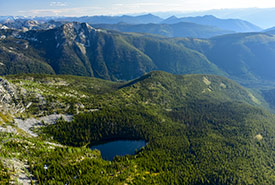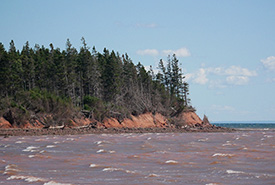Bear, Moose, Gray Wolf, Caribou, Dall Sheep

© Brad Josephs
There’s a new “Big Five” in town. Well, in Alaska, that is. Go beyond the famous quintuplet of creatures found on an African safari and head north, instead, to the Great Land. There you’ll meet Alaska’s brown bears, moose, gray wolves, caribou and Dall sheep—the “other” Big Five. From the shores of Prince William Sound to the rugged peaks of the Kenai Peninsula, from the temperate rain forests of the Chugach Mountains to the wild country outside Anchorage, an in-depth wildlife tour of the Great Land will, hopefully, put you within binocular distance (if not closer) of these majestic beasts.
Unique geography, varied ecosystems, culture and history are revealed as you drive to the Kenai Peninsula along scenic Seward Highway and through the Kenai Mountains and the Turnagain Arm National Heritage Area. It’s here, amidst low-elevation temperate rain forest and boreal forest, at tundra-covered alpine heights and alongside the rushing Kenai River, that we find Dall sheep, caribou, Alaskan moose, gray wolves and brown bears. We find them, too, on Kodiak and Admiralty islands, along Prince William Sound, in Denali National Park and more. To prepare you for your wildlife expedition to Alaska, we offer this primer on Alaska’s Big Five (and a few more besides).
Who Are the Alaska “Big Five”?
Brown Bears & Grizzlies

© Lindsey Nielsen
What’s the difference between a brown bear and a grizzly bear? Not much. While in the past these two bears were labeled by taxonomists as individual species, they’re both technically classified as Ursus arctos in the family Ursidae in the order Carnivora. Kodiak Island bears—physically and genetically secluded from other Alaskan brown bears—differ slightly in their skull shape.
Brown bears are bulkier than black bears (which you’ll find in large numbers across Alaska) and adapted a prominent shoulder hump and larger, straighter claws for feeding purposes. It’s that muscular shoulder hump that allows them to pick up speed quickly when pursuing caribou and Alaskan moose. The brown bears in Alaska (and the Kamchatka Peninsula) are about one-third larger than their cousins in Europe, North America and the sub-Arctic, due in part to their protein-heavy diet of salmon and the preponderance of rich berries in their habitat. In fact, some of the largest brown bears in the world live along the Alaskan and Katmai coasts and on the islands of Kodiak and Admiralty. These mature males can weigh up to 1,700 pounds and stand about 9 feet tall, while their female counterparts weigh up to 700 pounds.
Caribou

The “deer of the North” have played an important role in the Indigenous cultures of Alaska for eons, providing food and clothing. A wealth of this social herd animal would mean much celebration and feasting, while a scarcity would lead to famine and hardship. The caribou makes its way across both open tundra and through dense boreal forest, adapting easily to each habitat. Their migrations are more extensive and in larger herd numbers than any other North American land mammal!
These chionophiles (or “snow lovers”) have adapted to extreme Arctic conditions, with coats made of dense, hollow, club-shaped hairs; thin, curly underwool; and packed outside layer with countless small spaces of air. It’s nearly impermeable to the nastiest winds and weather of the far North.
We can distinguish caribou from other deer species by the fact that both sexes have antlers. (It is believed that no two pairs of antlers look the same, however.) The adult bulls shed their large antlers early in the winter, while the female cows shed theirs in June when calving time arrives (up until then, they use their antlers to claim and protect feeding areas). On a Nat Hab Alaska wildlife departure, you’re likely to see herds of caribou on Alaska’s coast, where the tidal flats have significantly fewer pesky black flies than the interior.
We know you’re wondering: What’s the difference between reindeer and caribou? It’s less about specific differences and more about the regions in which they roam. These habitats have shaped their physical idiosyncrasies. Caribou are slightly taller and have longer limbs, due to their enormous migrations over Canada and Alaska’s massive territories, sometimes traveling 3,000 miles over the course of a year in search of food sources. The species Rangifer tarandus is what we call caribou in North America, while in northern Europe and Asia they’re referred to as reindeer. (Within Scandinavia and Russia, when a caribou has been domesticated, it’s even more likely to be referred to as a reindeer.)
Gray Wolf

As elusive as their reputation suggests, the gray wolf may make an appearance on your trip to Alaska, but it’s rare. However, these sneaky creatures won’t stand for being left out of the Big Five. Thousands of years ago, they were the most widely distributed mammal on the planet, and even in 2018, gray wolves (Canis lupus) and their 37 subspecies were still found in more than 50 countries in North America, Europe, Asia, Africa and Australia.
As we travel throughout the Kenai Peninsula and along Prince William Sound, we continually keep an eye out for wolves, which may at first look like a large husky or Alaskan malamute. On closer glance, you’ll see they are much larger and inherently more powerful than your typical furry friend. Gray wolves can weigh up to 165 pounds, although they’re typically closer to 100 pounds. They’re about 2 to 3 feet tall at shoulder height and about 5 to 6.5 feet long.
“So,” you’re thinking, “my Bernese Mountain dog is a solid 125 pounds … is it as strong as a wolf?” In this case, your dog’s bark isn’t as big as its bite. Humans bite down at about 120–150 pounds per square inch. The strongest dog—a mastiff—bites at about 500 psi. Gray wolves, on the other hand, who rely on hunting prey that is oftentimes many times its own size, bite down at more than 1,200 psi!
Tough as they are, wolves are also built for traveling long distances—and quickly. They can cover up to 120 miles per day, at about 5 miles per hour. When they’re closing in on prey, they can sprint at 45 miles per hour.
If you’re fortunate enough to see a gray wolf in the wild, you’ll find it may not even be gray. Alaska has wolves that range from white or gray, to mottled gray and black, to completely black (gray and black are the most common). As we make our way to the little-visited Skilak Lake area, the western slopes of the Kenai Mountains and the forested lowlands, rivers, wetlands and chains of lakes in the Kenai National Wildlife Refuge, keep an eye out for these wily wolves.
Alaskan Moose

© Colin + Meg
Believe it or not, the massive moose can slip nearly undetected through Alaska’s thick brush and forest, making it difficult for biologists to get an accurate population count. It is estimated the state has about 175,000 moose, so it’s likely you’ll see one … or it may see you without you ever realizing it’s there! On our trips to Alaska, we scan the edges of waterways for these ornery, unpredictable creatures. (Keep your distance if you do see one, keeping as much space as possible between you and them.) With those long legs of theirs, they can move incredibly fast through water and deep snow.
Large male moose can weigh up to 1,600 pounds and be 6 feet tall, while females can weigh more than 1,000 pounds. And while moose are the largest members of the deer family, the Alaska-Yukon subspecies is the largest of all.
Male moose drop their antlers in January and start to regrow them in April or May, meaning if you’re visiting Alaska in the summer, you’ll notice the animals’ soft, spongy antlers covered with dark brown, velvety skin as the new pair starts to emerge. Each year, the size of the palmate shape, the number of tines and the antler spread continues to grow, until around age 6, when the antlers start to deteriorate, deform and grow slightly smaller each year. Female moose do not have antlers.
Dall Sheep

© NPS/Katie Thoresen
Often found high in the mountains of Denali National Park and Preserve, Dall sheep are natural alpinists. While sensitive to harsh weather, long-term environmental changes, predation, hunting and disease, the species is under constant watch by the National Park Service to better understand and protect them. Dall sheep are one of the six keystone large mammal species in interior Alaska (joining moose, caribou, black bear, brown bear and wolves), and approximately 20% of the world’s Dall sheep population resides in Central Alaska Network parklands.
These remarkable cliff hangers live on wind-swept, exposed cliffs and the rugged peaks of central and northern Alaska. The Dall subspecies lives only in Alaska and western Canada. We identify rams by their horns’ characteristic curl and their larger size, about 160 to 180 pounds on average. Females (ewes) have smaller, more slender horns and weigh approximately 100 to 110 pounds.
We will typically see Dall sheep at a distance when we scan open slopes and where vegetation can provide a contrasting backdrop to their white fur. Most of the estimated 50,000 sheep in Alaska inhabit terrain far from human byways, but we may be fortunate enough to glimpse them on Turnagain Arm near Anchorage, where they often venture close to Windy Corner, the southern terminus of the Turnagain Arm Trail in Chugach State Park. Often, you can see about a half-dozen of them congregating on the cliffs above the roadway.
Don’t Forget Us!
Not to be overlooked, humpback whales and bald eagles are a close No. 6 and No. 7 after Alaska’s Big Five. As we cruise by chartered boat in the Kenai Fjords, beneath the face of a calving glacier, look for breaching cetaceans. Float down the Kenai River, watching for bald eagles congregating in the sky above, signaling a salmon run in the water below them.
Remote Alaska trails and roads lead us to more amazing wildlife-viewing spots throughout the interior of the state, along the Kenai Peninsula and beside Prince William Sound. Look for seabirds, otters, seals, lynx, wood bison, elk, muskox, porcupine, foxes and more. We hope you will join us on a Nat Hab Alaska departure to see the new “Big Five” in the wild!




